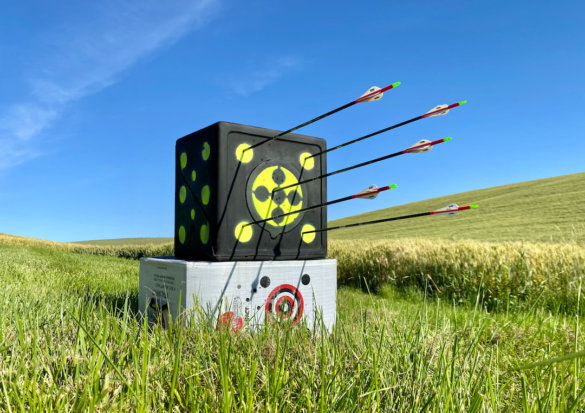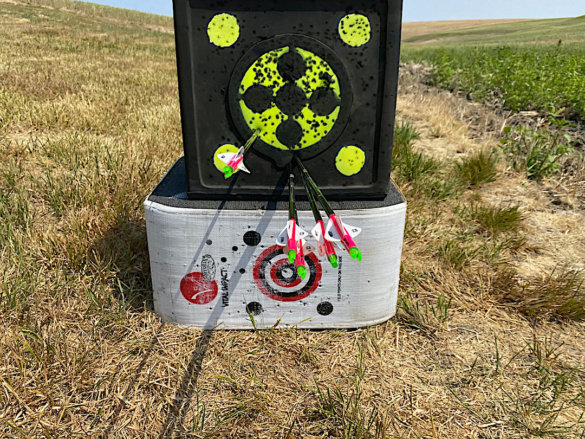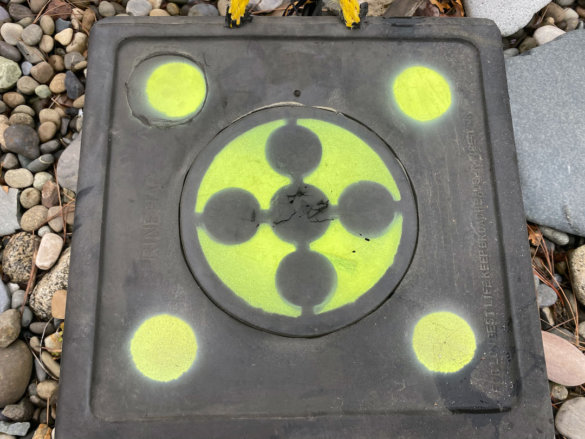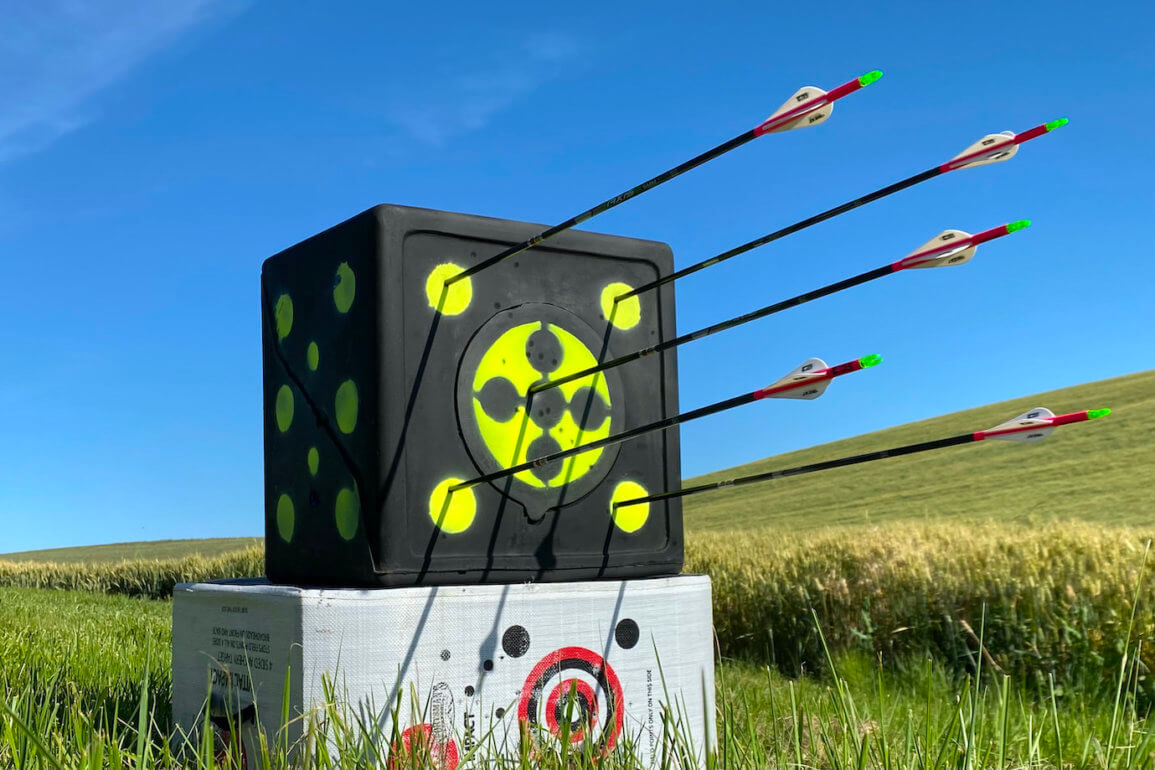The Rinehart RhinoBlock Archery Target is a heavy-duty self-healing, six-sided foam target with a replaceable center core.
If you shoot bows much at all, you likely know that the centers of targets wear out the fastest. Therefore, you probably like the idea of a replacement center insert. That’s what caught my attention, and that’s why I bought the Rinehart RhinoBlock target two years ago.
If you’re reading this long-term review, you likely want to know if the RhinoBlock target is worth the investment, how long it lasts, and how easily arrows pull out of it. Let’s take a closer look:
Why Choose the Rinehart RhinoBlock?

I previously shot at compressed layer foam targets, which are relatively inexpensive. Unlike bag-style targets, these layered foam targets let you shoot broadheads into at least two sides. If you’re a bowhunter, a broadhead capable target is critical to tuning and practice. The problem with layered foam targets is longevity. When they’re new, I love them: They stop everything and arrows slide out of them easily.
But after hundreds of shots, the centers start to deteriorate. Then, once you start testing broadheads, layered foam targets start to shred fast.
Enter Rinehart’s Signature Series Foam. Instead of layers, Rinehart’s foam block targets use a different type of very dense, self-healing foam. If you shoot an arrow into it then pull it out, the hole will essentially close up on itself. It does’t truly heal like a wound that reseals itself, but the foam around the arrow hole expands back into place . . . leaving behind a teeny tiny hole.
The Rinehart RhinoBlock is an ultra durable archery target that will stop thousands of arrows over multiple seasons.
Think of it this way: I’m not sure how many times you can shoot a field tipped arrow into the same quarter-sized spot on the RhinoBlock before losing appreciable performance, but I’m betting it’s many hundreds of shots.
If you extrapolate that repeat-arrow durability to the center 6-8 inches of the target, you’ll easily get thousands of shots. If you use all six sides and vary your shot routines, it’s not hard to imagine that you could get tens of thousands of field-point shots out of a RhinoBlock Archery Target.

So far I estimate that I’ve put about 4,000 shots into the RhinoBlock, most of those to the front with some side shooting to mix things up. I’ve purposely ignored the backside — just a few shots into it, so the back still looks new.
Shop Rinehart’s massive lineup of 3D animal targets at BlackOvis!
Broadhead Performance

Last summer I shot a couple hundred broadhead shots — something I never would have tried with a layered foam target. At first this was a mix of obsessive-compulsive tuning, then it was for consistency and then experience at longer distances and also with windy conditions. Aside from some tinkering, I primarily shoot single-bevel broadheads.
In my experience, the RhinoBlock has easily stopped each arrow. In fact, after all of these shots, I still don’t see field points or broadheads appear on the other side of the target. Even shots that manage to hit the replacement core seam don’t poke through the other side. If you practice in your garage at close range, you’ll appreciate the consistent stopping power.
This level of performance is a key reason why the RhinoBlock has been in our Best Gifts for Bowhunters list the last few years.
Easy Arrow Removal?
Rhinehart claims the arrows are easy to remove from the RhinoBlock target . . . but I must have sissy hands because my arrows aren’t that easy to remove. Of course, I shoot narrow 5mm Easton Axis arrows. And, because I hunt for elk, I like to shoot heavier arrows — 598 grains.
I have a buddy that shoots lighter arrows with a thicker diameter, and while I haven’t measured penetration in a side-by-side test, it seems as if his arrows are slightly easier to pull. So, if you shoot larger diameter, lighter arrows, your arrows might be easier to remove. I’ve also heard that Easton’s FMJ arrows that have carbon cores sheathed with aluminum pull easier.
For me, I use an arrow puller that I leave attached to the handle of the RhinoBlock Target with a cord so it always goes where the target goes. It lets me grip the smaller diameter arrows and pull them free relatively easily. Even so, arrow removal is harder than it is from layered foam targets.
I will say that after a few hundred shots in the center area, the center area starts to pull a bit easier — but performance still stops arrows just as well.
The Replaceable Insert Problem?

After a few months, the round internal replaceable core started getting punched backward by my arrows. So I’d pull my arrows and then bang it back into place so the surfaces would again be flush. Internally, there’s a plastic tube that’s cut and angled and designed to hold the core in place, and it looked as if mine had bent and lost that ability.
Having the core move and need to be adjusted after each round of shots was super annoying.
I thought about jamming something inside to keep it in place, but I didn’t want anything to damage any arrows. So this is what I did:
I pushed the replaceable center core about halfway out. I then sprayed around the exposed replacement core with some spray adhesive and quickly smacked the core back flush to the target.
Boom. Problem solved and it hasn’t moved since.
Check out the RhinoBlock Insert replaceable core pricing at BlackOvis!
Competition and Alternative Options
There are several different kinds of recreational archery targets. In general, layered foam targets are inexpensive and work with broadheads but don’t last a long time. Bag archery targets last for many shots but aren’t made for broadheads. Self-healing foam targets work with both broadheads and field points and last a long time but usually cost more. If you’re interested in the Rinehart RhinoBlock Archery Target, these alternative options might also work for you:
Rinehart RhinoBRUTE — Unlike the RhinoBlock and RhinoBlock XL, the RhinoBRUTE is a true 16″ cube. The main difference, however, is that it does not have a replaceable center core. Is the lack of a removable center core a drawback? Maybe, but with the full 16″ on each side, archers might be more likely to turn the cube and spread their shots out more than with the RhinoBlock . . . perhaps getting even more shots out of it. There is one more key difference: The RhinoBRUTE doesn’t have a sculpted deer vitals target side like the RhinoBlock versions do.
Delta McKenzie Big 8 Archery Target — The most obvious difference between the Rinehart RhinoBlock and the McKenzie Big 8 is the McKenzie’s 8-sided hexagonal shape. Like the RhinoBlock, the McKenzie has a removable core.
Morrell High Roller Foam Target — The Morrell High Roller Foam Target is shaped like a big die — the singular of dice. The sides have white dice-like markings, 1-6. I like the high-contrast circles, white on red, to shoot for. One drawback is the fewer targets on each side, but the target setup might also encourage shooters to use different sides more frequently than with other targets.
Matrix Target System — The key to the Matrix System is a series of removable, shiftable, and replaceable foam components. The M1 system uses seven hexagon blocks that stack together and are held in place by straps while the M2 system uses nine squares that stack and are locked into place with straps. The primary benefit is the ability to pound the center of the target with many shots, then, as it starts to wear out, move it off to a seldom hit side or corner. And continue rotating the blocks around through thousands of shots. The biggest drawback is the increased price point.
The Bottom Line
All-in-all, the Rinehart RhinoBlock Archery Target is a super-durable, long-lasting target that can easily handle thousands of arrows and many shots with broadheads. If you shoot enough to wear out the central core of the target, you can replace it with a new core. Very highly recommended.
Get the Gear:
Check shipping/pricing:
Bass Pro Shops | BlackOvis | Scheels | Sportsman’s Warehouse
Shop Rinehart’s massive lineup of 3D animal targets at BlackOvis!


